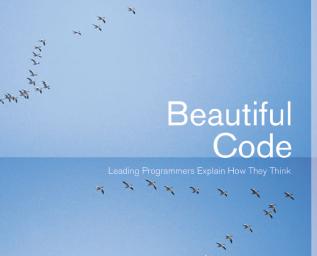資料介紹
How This Book Is Organized
Chapter 1, A Regular Expression Matcher, by Brian Kernighan, shows how deep insight into
a language and a problem can lead to a concise and elegant solution.
Chapter 2, Subversion’s Delta Editor: Interface As Ontology, by Karl Fogel, starts with a wellchosen
abstraction and demonstrates its unifying effects on the system’s further
development.
Chapter 3, The Most Beautiful Code I Never Wrote, by Jon Bentley, suggests how to measure a
procedure without actually executing it.
Chapter 4, Finding Things, by Tim Bray, draws together many strands in Computer Science
in an exploration of a problem that is fundamental to many computing tasks.
Chapter 5, Correct, Beautiful, Fast (in That Order): Lessons from Designing XML Verifiers, by
Elliotte Rusty Harold, reconciles the often conflicting goals of thoroughness and good
performance.
Chapter 6, Framework for Integrated Test: Beauty Through Fragility, by Michael Feathers,
presents an example that breaks the rules and achieves its own elegant solution.
Chapter 7, Beautiful Tests, by Alberto Savoia, shows how a broad, creative approach to testing
can not only eliminate bugs but turn you into a better programmer.
Chapter 8, On-the-Fly Code Generation for Image Processing, by Charles Petzold, drops down a
level to improve performance while maintaining portability.
Chapter 9, Top Down Operator Precedence, by Douglas Crockford, revives an almost forgotten
parsing technique and shows its new relevance to the popular JavaScript language.
Chapter 10, The Quest for an Accelerated Population Count, by Henry S. Warren, Jr., reveals
the impact that some clever algorithms can have on even a seemingly simple problem.
Chapter 11, Secure Communication: The Technology Of Freedom, by Ashish Gulhati, discusses
the directed evolution of a secure messaging application that was designed to make
sophisticated but often confusing cryptographic technology intuitively accessible to users.
Chapter 12, Growing Beautiful Code in BioPerl, by Lincoln Stein, shows how the combination
of a flexible language and a custom-designed module can make it easy for people with
modest programming skills to create powerful visualizations for their data.
Chapter 13, The Design of the Gene Sorter, by Jim Kent, combines simple building blocks to
produce a robust and valuable tool for gene researchers.
Chapter 14, How Elegant Code Evolves with Hardware: The Case of Gaussian Elimination, by
Jack Dongarra and Piotr Luszczek, surveys the history of LINPACK and related major software
packages to show how assumptions must constantly be re-evaluated in the face of
new computing architectures.
Chapter 15, The Long-Term Benefits of Beautiful Design, by Adam Kolawa, explains how
attention to good design principles many decades ago helped CERN’s widely used mathematical
library (the predecessor of LINPACK) stand the test of time.
Chapter 28, Beautiful Debugging, by Andreas Zeller, shows how a disciplined approach to
validating code can reduce the time it takes to track down errors.
Chapter 29, Treating Code As an Essay, by Yukihiro Matsumoto, lays out some challenging
principles that drove his design of the Ruby programming language, and that, by extension,
will help produce better software in general.
Chapter 30, When a Button Is All That Connects You to the World, by Arun Mehta, takes you
on a tour through the astounding interface design choices involved in a text-editing system
that allows people with severe motor disabilities, like Professor Stephen Hawking, to
communicate via a computer.
Chapter 31, Emacspeak: The Complete Audio Desktop, by T. V. Raman, shows how Lisp’s
advice facility can be used with Emacs to address a general need—generating rich spoken
output—that cuts across all aspects of the Emacs environment, without modifying the
underlying source code of a large software system.
Chapter 32, Code in Motion, by Laura Wingerd and Christopher Seiwald, lists some simple
rules that have unexpectedly strong impacts on programming accuracy.
Chapter 33, Writing Programs for “The Book”, by Brian Hayes, explores the frustrations of
solving a seemingly simple problem in computational geometry, and its surprising
resolution.

- C語言串口通信-源代碼pdf免費下載 24次下載
- 開關電源噪聲之EMC電子版資源下載 0次下載
- 課堂演示源代碼匯總下載 0次下載
- DSP載波移相控制C語言源代碼下載 57次下載
- Matlab系列之數組(矩陣)的生成資料下載
- Matlab系列之數組的基本操作資料下載
- Matlab系列之程序調試資料下載
- 串口通信之讀取與發送及LabView文件下載 184次下載
- STM32之DAC資料下載
- matlab應用程序及源代碼下載 36次下載
- PCB繞等長之“同組同層”資料下載
- 汽車電源設計之不改PCB如何降低EMI資料下載
- python代碼示例之基于Python的日歷api調用代碼實例 42次下載
- MSP430之系列用戶指導和示例代碼 28次下載
- [代碼整潔之道].(美)馬丁.掃描版 0次下載
- 【ModernCpp】新特性之CTAD代碼示例 493次閱讀
- C語言代碼的常用技巧 579次閱讀
- IDEA插件之代碼質量檢查利器 1166次閱讀
- 基于泰凌微電子平臺實現OpenHarmony開發——代碼下載和編譯步驟 1434次閱讀
- 代碼編程規范之注釋風格 1887次閱讀
- 代碼編程規范之命名規范 1401次閱讀
- Rust代碼啟發之返回值異常錯誤處理 2187次閱讀
- 使用鴻蒙JS框架寫出來的JS代碼長什么樣 2340次閱讀
- 機器學習:簡單的術語帶你領略貝葉斯優化之美 2075次閱讀
- CPU是如何識別代碼的 3654次閱讀
- 使用C語言實現萬年歷星期速算法的源代碼免費下載 3210次閱讀
- STM32F030之IAP代碼編寫 1.1w次閱讀
- 爛代碼你能忍嗎?優秀的代碼VS糟糕的代碼 4421次閱讀
- 如何編寫代碼與生成下載文件的簡單介紹 2807次閱讀
- 三菱變頻器常見故障代碼大全之原因與處理辦法 8.5w次閱讀
下載排行
本周
- 1電子電路原理第七版PDF電子教材免費下載
- 0.00 MB | 1490次下載 | 免費
- 2單片機典型實例介紹
- 18.19 MB | 92次下載 | 1 積分
- 3S7-200PLC編程實例詳細資料
- 1.17 MB | 27次下載 | 1 積分
- 4筆記本電腦主板的元件識別和講解說明
- 4.28 MB | 18次下載 | 4 積分
- 5開關電源原理及各功能電路詳解
- 0.38 MB | 10次下載 | 免費
- 6基于AT89C2051/4051單片機編程器的實驗
- 0.11 MB | 4次下載 | 免費
- 7藍牙設備在嵌入式領域的廣泛應用
- 0.63 MB | 3次下載 | 免費
- 89天練會電子電路識圖
- 5.91 MB | 3次下載 | 免費
本月
- 1OrCAD10.5下載OrCAD10.5中文版軟件
- 0.00 MB | 234313次下載 | 免費
- 2PADS 9.0 2009最新版 -下載
- 0.00 MB | 66304次下載 | 免費
- 3protel99下載protel99軟件下載(中文版)
- 0.00 MB | 51209次下載 | 免費
- 4LabView 8.0 專業版下載 (3CD完整版)
- 0.00 MB | 51043次下載 | 免費
- 5555集成電路應用800例(新編版)
- 0.00 MB | 33562次下載 | 免費
- 6接口電路圖大全
- 未知 | 30320次下載 | 免費
- 7Multisim 10下載Multisim 10 中文版
- 0.00 MB | 28588次下載 | 免費
- 8開關電源設計實例指南
- 未知 | 21539次下載 | 免費
總榜
- 1matlab軟件下載入口
- 未知 | 935053次下載 | 免費
- 2protel99se軟件下載(可英文版轉中文版)
- 78.1 MB | 537791次下載 | 免費
- 3MATLAB 7.1 下載 (含軟件介紹)
- 未知 | 420026次下載 | 免費
- 4OrCAD10.5下載OrCAD10.5中文版軟件
- 0.00 MB | 234313次下載 | 免費
- 5Altium DXP2002下載入口
- 未知 | 233045次下載 | 免費
- 6電路仿真軟件multisim 10.0免費下載
- 340992 | 191183次下載 | 免費
- 7十天學會AVR單片機與C語言視頻教程 下載
- 158M | 183277次下載 | 免費
- 8proe5.0野火版下載(中文版免費下載)
- 未知 | 138039次下載 | 免費
 電子發燒友App
電子發燒友App

















 創作
創作 發文章
發文章 發帖
發帖  提問
提問  發資料
發資料 發視頻
發視頻 上傳資料賺積分
上傳資料賺積分









評論